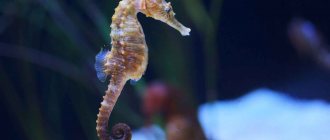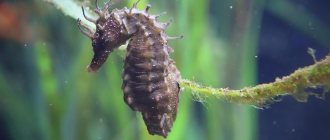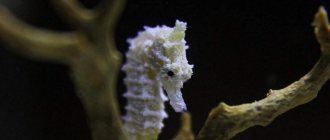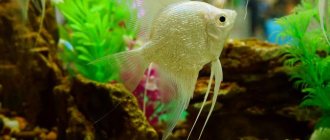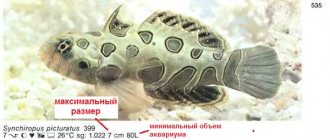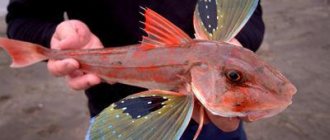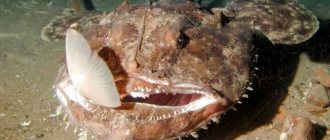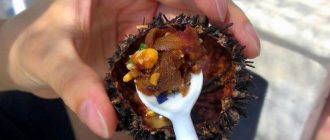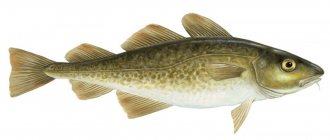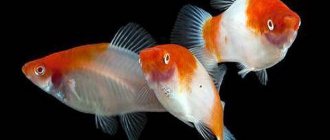13 September69048aquatic inhabitantsseahorsesspined sticklebacks
The seahorse is a small fish, which is a representative of the Spine family from the order Stickleback. Research has shown that the seahorse is a highly modified pipefish. Today the seahorse is a rather rare creature. In this article you will find a description and photo of a seahorse and learn a lot of new and interesting things about this extraordinary creature.
Origin of the species and description
Photo: Seahorse
Seahorses belong to the genus of ray-finned fish from the order Acidaceae. Research conducted on seahorses has shown that seahorses are a highly modified subspecies of pipefish. Like needlefish, seahorses have an elongated body shape, a unique structure of the oral cavity, and a long, mobile tail. Not many remains of seahorses have been found - the earliest date back to the Pliocene, and the separation of pipefish and seahorses occurred in the Oligocene.
Video: Seahorse
The reasons are not precisely established, but the following stand out:
- the formation of multiple shallow waters, where fish often swam as vertically as possible;
- the spread of numerous algae and the occurrence of currents. Thus, the fish had a need to develop the grasping functions of the tail.
There are colorful varieties of seahorses that are not unanimously classified as this species by all scientists.
Some of the most colorful seahorses are:
- pipefish. In appearance it resembles a tiny seahorse with a very elongated thin body;
- the spiny seahorse has strong long spines all over its body;
- sea dragons, especially leafy ones. They have a characteristic camouflage shape, as if completely covered with leaves and algae shoots;
- the dwarf seahorse is the smallest representative of seahorses, measuring barely more than 2 cm;
- The Black Sea pipit is a species that does not have spines.
Neighbors in the aquarium
Next door you can place calm fish or invertebrates in the aquarium. The fish should be small, slow and careful. Ideal neighbors for seahorses would be blennies and gobies. They get along well with a snail, which does not sting corals and cleans the aquarium perfectly. You can also consider living stones as inhabitants of the “house” of needle-shaped fish. These are small pieces of limestone that have been in warm tropical waters for some time and are inhabited by various living organisms. All new neighbors must be healthy to avoid infecting the seahorses.
If you read reviews about seahorse breeding, people write that for two pairs of these fish you need an aquarium volume of 150 liters.
Appearance and features
Photo: What a seahorse looks like
The seahorse got its name not by chance - its body shape resembles a chess knight. The elongated curved body is clearly divided into head, body and tail. The seahorse is completely covered with chitinous growths that have a ribbed shape. This gives it a resemblance to algae. The height of seahorses varies, depending on the species it can reach 4 cm or 25 cm. It also differs from other fish in that it swims vertically, holding its tail down.
This is explained by the fact that the abdominal bladder is located in the abdominal and head parts, and the head bladder is larger in size than the abdominal one. Therefore, the head seems to “float” up. The fins of the seahorse are small and serve as a kind of “rudder” - with their help it turns around in the water and maneuvers. Although seahorses swim very slowly, relying on camouflage. There is also a dorsal fin that allows the seahorse to maintain an upright position at all times.
Interesting fact: Seahorses can look different - sometimes their shape resembles algae, rocks and other objects among which they are camouflaged.
The seahorse has a sharp, elongated muzzle with pronounced large eyes. The seahorse does not have a mouth in the classical sense - it is a tube, similar in physiology to the oral cavities of anteaters. It draws water into itself through a tube to feed and breathe. The color can be very diverse, it also depends on the habitat of the seahorse. The most common species have a gray chitinous cover with rare small black dots. There are types of bright colors: yellow, red, green. Often the bright color is accompanied by corresponding fins that resemble algae leaves.
The tail of the seahorse is interesting. It is curved and unbends only during intense swimming. With this tail, seahorses can cling to objects to hold on during strong currents. The abdominal cavity of seahorses is also noteworthy. The fact is that the reproductive organs are located there. In females this is the ovipositor, and in males it is the abdominal pouch, which looks like a hole in the middle of the abdomen.
Where does the seahorse live?
Photo: Seahorse in the water
Seahorses prefer tropical and subtropical waters, and the water temperature must be stable.
They can most often be found along the following coasts:
- Australia;
- Malaysia;
- Philippine Islands;
- Thailand.
Most often they live in shallow water, but there are species that live in depth. Seahorses lead a sedentary lifestyle, hiding in algae and coral reefs. They grab hold of various objects with their tails and make occasional dashes from stem to stem. Due to their body shape and color, seahorses are excellent at camouflage.
Some seahorses can change color to suit their new environment. This is how they camouflage themselves from predators and get their food more efficiently. The seahorse makes long journeys in a peculiar way: it clings to some fish with its tail, and detaches itself from it when the fish gets into algae or reefs.
Now you know where the seahorse is found. Let's see what this animal eats.
Fish habitat and nutrition
To date, about 50 species of seahorses have been described, more than half of which are listed in the Red Book. They live in tropical and subtropical coastal waters. About six species of fish were discovered in the Red Sea, and in the seas washing the shores of Russia, two types are found - the Black Sea and the Japanese. Their main habitat is the coastal waters of Italy and the Canary Islands.
These creatures lead a sedentary lifestyle and can be found mainly in dense thickets of algae and other marine vegetation. The seahorse is capable of traveling long distances by clinging with its tail to the fins of fish and waiting until they begin to swim through thickets of algae.
These cute and seemingly harmless creatures are predators. The basis of their diet consists of crustaceans, shrimp and plankton. Their way of eating is quite interesting. Having caught its tail in the algae, the seahorse remains motionless, waiting for prey. Having noticed a shrimp, the fish turns its tubular snout towards it and puffs out its cheeks, pulling the victim into its mouth along with the water. They are able to do this even from a distance of 3 cm.
Seahorses eat quite a lot and can hunt throughout the day, taking only short breaks. Approximately 3-4 thousand crustaceans are eaten per day.
What does a seahorse eat?
Photo: Seahorse
Due to the peculiar physiology of the mouth, seahorses can only feed on very small food. It draws water into itself like a pipette, and along with the flow of water, plankton and other small food enter the seahorse’s mouth.
Large seahorses can suck in:
- crustaceans;
- shrimp;
- small fish;
- tadpoles;
- eggs of other fish.
It is difficult to call a seahorse an active predator. Small species of seahorses feed continuously by sucking in water. Large seahorses resort to camouflage hunting: they cling to algae and coral reefs with their tails, waiting for suitable prey to be nearby.
Due to their slowness, seahorses do not know how to pursue prey. During the day, small species of seahorses eat up to 3 thousand crustaceans in plankton. They feed continuously at any time of the day - the fact is that the skate does not have a digestive system, so it has to be fed constantly.
Interesting fact: It is not uncommon for seahorses to eat larger fish; They are indiscriminate in their eating - the main thing is that the prey fits into the mouth.
In captivity, seahorses feed on daphnia, shrimp and special dry food. The peculiarity of feeding at home is that the food must be fresh and supplied regularly, otherwise the seahorses may get sick and die.
Aquarium
It is necessary to monitor the temperature of the water in the aquarium. The optimal water temperature for them is approximately 23-25 degrees Celsius. For hot days, you need to take care of installing an aquarium split system or turn on a fan nearby. Otherwise, hot air has a detrimental effect on these fish, and they will simply suffocate.
In order for a seahorse to feel comfortable at home in an aquarium, it is necessary to monitor the quality of the water in it. The water in the aquarium should not contain ammonia or phosphates. You need to put corals and algae on the bottom. Various grottoes, jugs, castles and other products made from artificial materials are also welcome.
Features of character and lifestyle
Photo: Orange seahorse
Seahorses lead a sedentary lifestyle. The maximum speed they can reach is up to 150 meters per hour, but they move extremely rarely, if necessary. Seahorses are non-aggressive fish that never attack other fish, even though they are predators. They live in small flocks of 10 to 50 individuals and have no hierarchy or structure. An individual from one flock can live peacefully in another flock.
Therefore, despite living in groups, seahorses are independent individuals. Interestingly, seahorses can form long-term monogamous pairs. Sometimes such a union lasts the entire life of seahorses. A pair of seahorses - a male and a male - is formed after the first successful breeding of offspring. In the future, the couple reproduces almost continuously, if there are no factors preventing this.
Seahorses are extremely susceptible to all kinds of stress. For example, if a seahorse loses its partner, it loses interest in reproduction and may completely refuse to eat, which is why it dies within 24 hours. Capturing and relocating to aquariums is also stressful for them. As a rule, caught seahorses must undergo adaptation from qualified specialists - captured individuals are not transplanted into aquariums with ordinary hobbyists.
Wild seahorses adapt extremely poorly to domestic conditions, most often become depressed and die. But seahorses born in aquariums calmly survive living at home.
Experiment
One day scientists conducted an experiment. A pair of males and a pair of females were placed in one aquarium to breed seahorses. After all the traditional courtship, the female laid her eggs to one of the males for further fertilization. The fertilized male was removed to a nearby aquarium. The remaining male tried to court this female, but all his efforts were in vain. She did not pay attention to him and did not try to lay eggs in his pouch. When they finally returned the male back to the aquarium with the female, she again chose him to fertilize her offspring. So he was removed again and again after the eggs were placed on him. Despite the fact that the second male continued to court her, the female seahorse still chose her previous male to reproduce. The experiment with fish was done 6 times - everything remained unchanged.
Social structure and reproduction
Photo: Seahorse in the sea
Seahorses do not have a fixed mating season. Males, reaching sexual maturity, begin to circle around the chosen female, demonstrating their readiness to mate. During this period, the soft area of the male's chest, not protected by chitin, darkens. The female does not react to these dances, freezes in place and watches the male or several males at once.
Some large species of seahorses are able to inflate a pouch on their chest. This ritual is repeated for several days until the female chooses a male. Before mating, the chosen male can “dance” all day until he is exhausted. The female signals the male that she is ready to mate when she rises closer to the surface of the water. The male follows her, opening his bag. The female's ovipositor expands, she inserts it into the opening of the pouch and lays eggs directly into the male's pouch. He simultaneously impregnates her.
The amount of fertilized eggs depends largely on the size of the male - a larger male can fit more eggs into his pouch. Small tropical species of seahorses produce up to 60 eggs, large species more than five hundred. Sometimes seahorses form stable pairs that do not break up throughout the life of the two individuals. Then mating occurs without rituals - the female simply lays eggs in the male’s pouch.
After four weeks, the male begins to release fry from the bag - this process is similar to “shooting”: the bag expands and many fry quickly fly out to freedom. To do this, the male swims out to an open area where the current is strongest - this way the fry will spread over a wide area. The parents are not interested in the further fate of the little seahorses.
Natural enemies of the seahorse
Photo: Seahorse in Crimea
The seahorse is a master of camouflage and secret living. Thanks to this, the seahorse has very few enemies who would purposefully hunt this fish.
Sometimes seahorses become food for the following creatures:
- large shrimp feast on small seahorses, hatchlings and caviar;
- crabs are the enemies of seahorses both underwater and on land. Sometimes seahorses cannot hold on to the seaweed during a storm, which is why they are washed ashore, where they become prey for crabs;
- clownfish live in corals and anemones, where seahorses are often found;
- the tuna may simply eat everything in its path, and seahorses accidentally end up in its diet.
Interesting fact: Undigested seahorses have been found in the stomachs of dolphins.
Seahorses are not capable of self-defense and do not know how to escape. Even the fastest subspecies will not have enough speed to escape pursuit. But seahorses are not hunted purposefully, since most of them are covered with sharp chitinous spines and growths.
Interesting information
Unusual facts will help you better understand what a seahorse is and how it exists:
- A female and a male individual are involved in the reproduction process. The eggs are laid by the female, but it is the male who handles their fertilization and subsequent gestation. He carries it in a bag located on his stomach. At the final stage, he shoots out small seahorses.
- Another interesting feature. Skates have eyes like a chameleon. They are able to move independently of each other.
- The name is due to its special structure. This underwater inhabitant resembles a chess knight in the shape of its body.
- The fish swims only vertically. Because of this, its movements are slower than those of other fish; the tail is always curved; it straightens only when the fish is in a hurry.
- A seahorse can easily live in an aquarium, but the owner will have to take care of creating all favorable conditions. In captivity, this fish becomes extremely demanding.
- In Asian countries, medicines are prepared from seahorses, and in Thailand they are even caught to eat.
- Undissolved seahorses were found in the stomachs of dolphins during autopsy. They swallow them, but cannot bite or digest them.
- For most of its life, the horse is not mobile. It clings to the seaweed with its tail and hangs near it.
The seahorse is a small peaceful fish that risks leaving the underwater world thanks to humans. Every year thousands of individuals are simply destroyed. People catch them to make souvenirs, dry them and use them for crafts; famous fish restaurants offer to prepare exotic dishes from these small fish. This is the case when the facts are eloquent. Already today, 30 existing species are included in the Red Book and it is time for people to think about their relationship to nature.
@ CataleyaLifedesign pixabay.com
Long-snouted seahorses were the first to be included in the Red Book of Ukraine back in 1994. According to certain information, they previously lived in the Black Sea.
The seahorse is an amazing and unusual fish that is often mistakenly considered an animal. This type is distinguished by a capacious variety of shapes, shades and sizes and is one of the most memorable and effective. The worst thing is that the species may die due to the work of poachers, so we can only hope that the protective measures will work and be effective.
Population and species status
Photo: What a seahorse looks like
Most species of seahorses are on the verge of extinction. Data on the number of species is controversial: some scientists identify 32 species, others more than 50. However, 30 species of seahorses are close to extinction.
The reasons for the disappearance of seahorses are different. This includes:
- mass capture of seahorses as souvenirs;
- catching seahorses as delicacies;
- environmental pollution;
- changing of the climate.
Seahorses are extremely susceptible to stress - the slightest change in the ecology of their habitat leads to the death of seahorses. Pollution of the world's oceans is decimating the population of not only seahorses, but also many other fish.
Interesting fact: Sometimes a seahorse can choose a female that is not yet ready to mate. Then he still carries out all the rituals, but in the end mating does not occur, and then he looks for a new partner.
